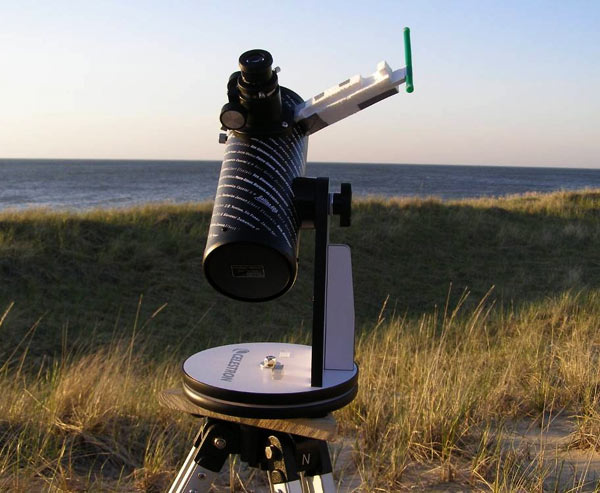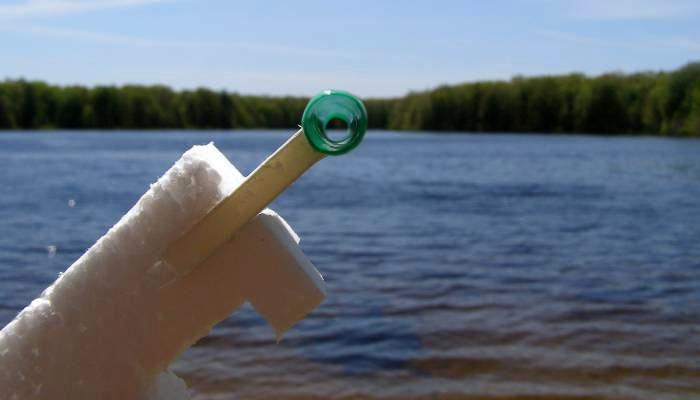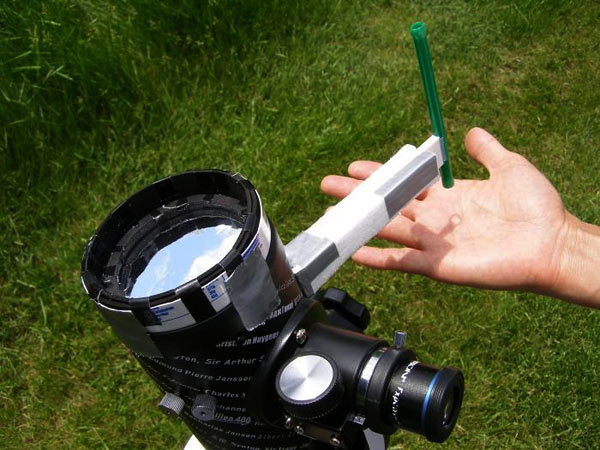


You all saw Norb Vance’s nice article about Celestron Firstscope in May 2009 newsletter (see “Tiny Telescope: A Step into the Past.” by Norbert Vance. Printed in Reflections: May, 2009). Many thanks to Norb, he was so generous to let me use the scope like it was mine. I had a lot of fun with it that night and was very impressed with how this tiny 3 inch “mini Dob” performed.
The scope is inexpensive (SMRP is $49.99), very portable and easy to use, yet the performance is surprisingly good. It is also “ready to use” right out of the box. I saw some beauty in the concept of this product.
I got to like the scope and I soon picked one up one for myself from Rider’s hobby shop.
The scope is a newtonian reflector on a Dobsonian type mount. The aperture is 76mm (approx. 3”) and the focal length is 300mm. It is small (16” max. height) and light weight (4.3 lbs).
The primary mirror seems to be glued to the bottom of the tube and not adjustable. The secondary is attached with a single vane and can be collimated. The scope comes with two eyepieces, H 20mm (Huygens) and SR 4mm (Ramsden). They are surely usable, but I find they have rather small apparent FOV’s and for SR 4mm eye relief is rather short. So I tend to use Orion Expanse eyepiece set (20mm, 15mm, 9mm, and 6mm) more often instead. With a 20mm Orion Expanse, it covers very wide field (more than 4 degrees FOV) with 15X magnification. To have higher magnification I use a 2X barlow. The combination works well.
Initially, I encountered two difficulties:
1) The telescope is so small so for adults it is hard to look through unless it sits on a base with reasonable height.
2) There was no finder on the scope (unless you buy an additional kit) and it was hard to get the object inside the FOV of the eyepiece, despite the large FOV it covers.
The first problem could be solved if you have a picnic table or something, but Peach mountain does not have one. I have a small portable table but it is not very rigid and I don’t want to put a telescope on it to observe. So what I did was to make a base/adaptor for a tripod. The base has holes to fit the legs of the base of the scope, and it is secured to the tripod by a screw at the center.
For the second problem, the easiest solution would be to put a reflex finder like Rigel or Telrad. But I didn’t want to spend an additional $40 for a $50 scope. Not because I thought the $50 scope didn’t deserve a $40 finder, but I thought it defeats the concept of the product. And the scope has such a wide FOV to begin with, so all I needed was to be able to aim the scope “fairly close” to the target to have the object inside the FOV of about 4 degrees with 20mm eyepiece.

So I made up a low cost “straw finder”. It is made of a straw, a piece of Styrofoam, foam board, magnet, and some tapes. All materials were readily found at home. The finder attaches anywhere on the scope body with the magnet at the bottom. Aim is easily adjusted by the magnet (left-right) and by the foam board attached to the straw (up-down). The finder is small enough to be stored on the scope base. I could easily aim the scope fairly accurately by looking through the center of the straw.

Soon after I built the finder I tested it with the moon, Saturn and some bright stars from my balcony. The result was encouraging. Then one night I tested under a darker sky and found it more difficult to use. The reason was on my balcony there were enough lights around to make the straw easily visible, but not under dark skies.
To solve this problem I applied small amount of “glow in dark” paint at the tips of the straw. After being exposed to a flashlight for a short time, the straw faintly glows. Looking through the straw I can see two greenish “rings” and by aligning them to the object I can set the aim fairly accurately. Now finding objects became much easier. I can even use “geometry method” to find deep sky objects that are not visible with naked eyes.

I also was able to use one of the solar filters I had made for my 15x70 binocular. The finder works perfectly in this case, by projecting the shadow of the straw on a screen in this case my hand is the screen.

I first observed objects like the moon, Saturn, and double stars from the balcony of my apartment in Ypsilanti. I was pleased with the views, and wanted to check out the scope’s capabilities for DSO’s in dark skies. In May I made a trip to northern Michigan and took the scope with me. I even took the scope for a backpacking trip to Lake Michigan shore. Here’s the brief report of observations through the scope.
Under good seeing condition, the scope provided good amount of details of Saturn and Jupiter. I mostly used 100X (2X Barlow + 6mm eyepiece) for planetary viewing, sometimes 150X if seeing was good. 150X seemed to be about the magnification limit for this scope.
Saturn: The ring, the gap between the ring and the planet, and the shadow of the ring on the planet were visible. Titan was easily visible. Hint of one or two more moons seen under good condition.
Jupiter: Two stripes were obvious. Another band in south was visible. All four moons were easily visible.
The scope’s wide FOV was perfect for large bright open clusters. The whole M44 (Beehive) fit nicely in the FOV when 20mm or 15mm eyepiece was used. Clusters such as M6, M7, M23, and Coathanger all provided very nice views. Individual stars of M11 were seen under dark skies but washed out under light polluted skies.
For bright globulars such as M13, M22, M3, M5, M4, and M15, individual stars were seen at higher power. For dimmer globulars granulation was difficult to see, but I was able to find all M54, M70, and M69 (“bottom of teapot” globulars).
M57’s ring shape was clearly seen with higher power. For M27 dumbbell shape was easily seen. I was able to detect Eskimo nebula and Ghost of Jupiter but it was difficult to see details for those small planetary nebulae.
North American nebula: Under dark sky this was one of the best views I ever had for this object. The shape of the nebula was so obvious and Yumi was able to see the whole shape for the first time. I could also see Pelican nebula. A nebula filter worked well.
Veil nebula: Both NGC6992 and NGC 6960 were easily detected under dark sky. Good amount of details was seen, especially for NGC6992.
M8, M20, and M21: All three fit in the same FOV with 15mm Expanse. Very nice view. Nebulosity was bright and obvious for both M8 and M20. Could not see the “split” of M20.
M16 and M17: Could fit both in the same FOV. Very nice view. Nebulosity was bright and obvious for both. M17’s “checkmark” was easily visible and the “parachute” was also seen under dark skies.
M81 and M82: Easy to find and appear fairly bright. Both easily fit in FOV. Nice views.
M51: Brighter than I expected. Hint of spiral was visible under dark skies.
M101: Again brighter than expected. Spiral structure was not seen.
M104: Hint of dust lane visible
NGC4565: Edge on shape was visible with averted vision. Dust lane difficult.
M31: I saw this early in the morning at northern Michigan. Wonderful view. With 15mm Expanse the whole galaxy fills the FOV of about 3 degrees. M32 and M110 were easily visible.
The scope provided nice views of easy doubles, such as Mizar, Cor Caroli, Kappa Hercules, Iota Cancuri, Albireo, etc. Companion of Polaris looked faint under light polluted sky but was easy under a dark sky. Tighter doubles such as Castor, Alpha Hercules, Gamma Leonis, and 54 Leonis were all split at 100X. Color contrast of Alpha Hercules was seen albeit faint. I tried to split Izar and Porrima but wasn’t successful.
Of course the views were not as spectacular compared to larger scopes. But overall, the performance further exceeded what I had expected. I believe this scope is one of the best starter scopes on market now especially for young astronomers, but it could also be a great grab and go scope for more experienced observers.